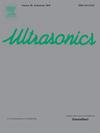Study on the vibration performance and sound field of a novel push-pull ultrasonic transducer with slotted tube
IF 3.8
2区 物理与天体物理
Q1 ACOUSTICS
引用次数: 0
Abstract
To address the challenges in ultrasonic processing for large capacity liquids, improving the electroacoustic conversion efficiency, expanding the radiation direction, and enhancing the uniformity of the sound field have become imperative and focal objectives in the design of high-power ultrasonic transducers. Hence, a novel push-pull slotted tube ultrasonic transducer (PSTUT) based on longitudinal-bending mode conversion has been proposed. The PSTUT is composed of four key parts: two sandwich transducers, two stepped horns, two end caps, and a slotted tube radiator. By applying push-pull longitudinal excitation, the caps produce longitudinal bending vibration, while the arc-shaped plates produce radial bending vibration, capable of achieving efficient, uniform, and omnidirectional ultrasound radiation. Based on the principle of electromechanical analogy and the theory of Timoshenko beams, the electromechanical equivalent circuits of the uniform beam in bending vibration and the PSTUT in coupled vibration are established. The frequency response of the PSTUT is validated by the finite element method simulations and experiments. The vibration analysis demonstrates that adjusting the size of the circular slotted tube radiator can control both the range and intensity of radial radiation. Simulated and experimental results show that the PSTUT exhibits satisfactory 3D-omnidirectional radiation capability and improved sound field uniformity in water. The proposed PSTUT offers a promising solution to overcome the bottleneck in ultrasonic liquid treatment technology.
求助全文
约1分钟内获得全文
求助全文
来源期刊

Ultrasonics
医学-核医学
CiteScore
7.60
自引率
19.00%
发文量
186
审稿时长
3.9 months
期刊介绍:
Ultrasonics is the only internationally established journal which covers the entire field of ultrasound research and technology and all its many applications. Ultrasonics contains a variety of sections to keep readers fully informed and up-to-date on the whole spectrum of research and development throughout the world. Ultrasonics publishes papers of exceptional quality and of relevance to both academia and industry. Manuscripts in which ultrasonics is a central issue and not simply an incidental tool or minor issue, are welcomed.
As well as top quality original research papers and review articles by world renowned experts, Ultrasonics also regularly features short communications, a calendar of forthcoming events and special issues dedicated to topical subjects.
 求助内容:
求助内容: 应助结果提醒方式:
应助结果提醒方式:


